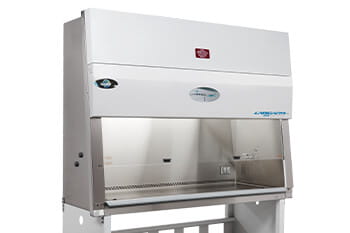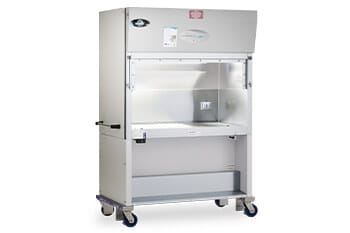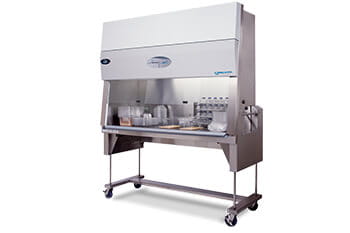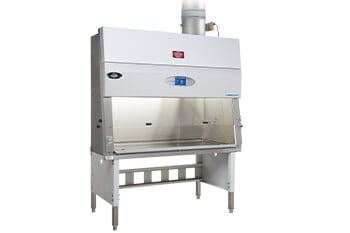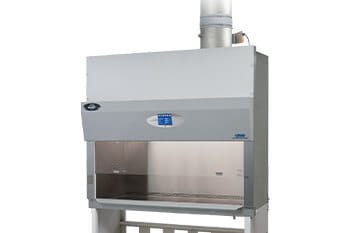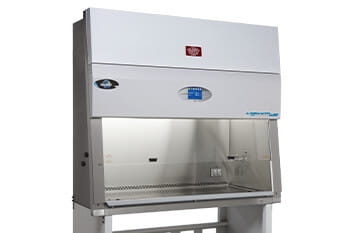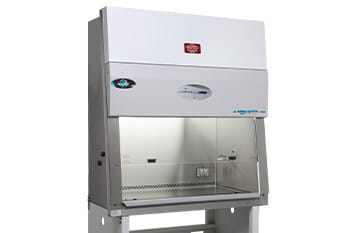Article
What is a Biosafety Cabinet Used For?
6/7/2024A biosafety cabinet (BSC) is vital for handling infectious agents or hazardous materials in any laboratory. Designed to protect laboratory personnel and the environment, BSCs are essential for ensuring safety and maintaining the integrity of scientific work. Additionally, some classes of biosafety cabinets offer extra protection for the product or research material. Here, we explore what a BSC is, its types, and its various applications in the laboratory.
Understanding Biosafety Cabinets
A Biosafety Cabinet is an enclosed, ventilated laboratory workspace designed to protect the user, the environment, and the material being worked on from exposure to infectious agents and other biological hazards. BSCs achieve this through a combination of laminar airflow and high-efficiency particulate air (HEPA) filtration, which creates a clean air environment inside the cabinet and minimizes the escape of contaminants.
BSCs are classified into different types based on their design, airflow pattern, and the level of protection they offer:
- Class I BSCs: Provide personnel and environmental protection but do not protect the product inside the cabinet. They are suitable for work involving low to moderate-risk agents.
- Class II BSCs: Provide personnel, environmental, and product protection. They are further divided into Type A1, A2, B1, B2, and C1, each with specific airflow patterns and applications.
- Class III BSCs: Also known as glove boxes, these cabinets provide the highest level of protection for personnel, environment, and product. They are used for work with high-risk biological agents.
Applications of Biosafety Cabinets
1. Microbiological Research
Biosafety Cabinets (BSCs) are extensively used in microbiological research to handle pathogens, bacteria, viruses, and fungi. As primary barriers, they provide a controlled environment that prevents contamination of samples and protects researchers from exposure to potentially harmful microorganisms. According to the Biosafety in Microbiological and Biomedical Laboratories (BMBL) guidelines, a BSC is required by a risk assessment. BSCs are crucial for tasks such as:
- Culturing bacteria and viruses.
- Isolating and identifying pathogens.
- Conducting sensitivity testing of antimicrobial agents.
2. Pharmacy Compounding
In healthcare system pharmacies, Biosafety Cabinets (BSCs) are indispensable for compounding sterile medications, particularly in the preparation of injectable drugs. As Containment Primary Engineering Controls (C-PECs), they ensure that Compounded Sterile Preparations (CSPs) are free from microbial contamination, which is critical for patient safety. BSCs in pharmacy settings are used to comply with the Engineering Control requirements of U.S. Pharmacopeia guidelines USP 797 and USP 800. Tasks performed in BSCs in compounding pharmacy settings include:
- Compounding intravenous (IV) medications.
- Preparing total parenteral nutrition (TPN) solutions.
- Mixing chemotherapeutic agents.
3. Clinical and Diagnostic Laboratories
Clinical laboratories use BSCs to handle patient samples, especially those that may contain infectious agents. This is essential for diagnostic testing and research involving human pathogens. Common uses include:
- Handling blood, urine, and tissue samples.
- Performing diagnostic tests for infectious diseases.
- Conducting molecular diagnostics and genetic testing.
4. Biotechnology and Genetic Engineering
In biotechnology and genetic engineering labs, BSCs provide a sterile environment for manipulating DNA, RNA, and other biological materials. They are essential for techniques such as:
- Cloning and gene editing.
- Polymerase chain reaction (PCR) setups.
- Producing recombinant proteins.
5. Vaccine Development and Production
BSCs play a crucial role in the development and production of vaccines. They ensure that external agents do not contaminate the vaccine cultures and that the personnel are protected from exposure to the pathogens used in vaccine production. Key activities include:
- Growing viral and bacterial cultures for vaccine production.
- Purifying vaccine components.
- Conducting quality control tests.
6. Environmental Testing
Biosafety Cabinets are used in environmental testing laboratories to analyze soil, water, and air samples for microbial contamination. They help prevent cross-contamination between samples and protect laboratory workers from exposure to hazardous substances.
7. Tissue Culture and Cell Biology
In cell biology and tissue culture laboratories, BSCs provide a sterile environment necessary for growing and maintaining cell lines. They are used for:
- Culturing primary cells and cell lines.
- Performing tissue engineering experiments.
- Studying cell behavior and functions.
8. Use in the Animal Laboratory
Biosafety cabinets designed for the vivarium offer specific design features such as pre-filters that capture animal hair and dander to extend filter life, larger work access openings to fit mouse and rat cages, and a smooth work surface not dished to accommodate the ease of moving cages in and out of the work zone. Cabinets are used for cage changing or procedural work providing ISO Class 5 air. Applications include:
- Cage changing
- Performing surgical procedures
- Handling small animals
- Conducting experimental procedures on animals
- Administering treatments or medications to animals
Ensuring Safe and Effective Use
Proper use and regular maintenance are essential to maintain the safety and effectiveness of Biosafety Cabinets. Laboratory personnel must be trained in the correct operation of BSCs, including proper aseptic techniques and decontamination procedures. Key practices include:
- Training: Ensuring all users are trained in proper techniques that do not interfere with the cabinet airflow.
- Routine Maintenance and Certification: Regularly inspect and maintain the BSC to ensure it operates correctly. This includes replacing HEPA filters, checking airflow patterns, decontaminating the interior surfaces, and having the BSCs regularly certified by qualified technicians.
- Proper Placement: Positioning the BSC in a location that minimizes airflow disruptions and avoids high-traffic areas to maintain optimal performance.
- Using Ergonomic Practices: Implementing ergonomic practices reduces user fatigue and prevents repetitive strain injuries.
Conclusion
Biosafety Cabinets are indispensable tools in modern laboratories, protecting personnel, the environment, and research material. Their applications span various scientific disciplines, from microbiology and pharmaceuticals to biotechnology and environmental testing. By providing a controlled, sterile environment, BSCs ensure the integrity of scientific research and the safety of those who conduct it. Proper training, maintenance, and adherence to best practices are critical to maximizing the benefits of these vital laboratory tools.

